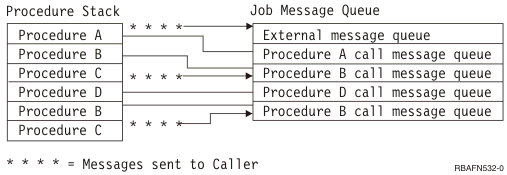A call message queue is used to send messages between one program or procedure and another program or procedure.
As long as a program or procedure is on the call stack (has not returned yet) its call message queue is active and messages can be sent to that program or procedure. Once the program or procedure returns, messages can no longer be sent to it. Message types which can be sent to a call message queue include informational, request, completion, diagnostic, status, escape, and notify.
The call message queue for an OPM program or ILE procedure is created when that program or procedure is called. The call message queue is exclusively associated only with the call stack entry in which the program or procedure is running. A call message queue is identified indirectly by identifying the call stack entry. A call stack entry is identified by the name of the program or procedure that is running in that call stack entry.
In the case of an OPM program, the associated call stack entry is identified by the (up to) 10 character program name. In the case of an ILE procedure, the associated call stack entry is identified by a three part name which consists of the (up to) 4096 character procedure name, the (up to) 10 character module name, and the (up to) 10 character program name. The module name is the name of the module into which the procedure was compiled. The ILE program name is the name of the ILE program into which the module was bound.
When identifying the call stack entry for an ILE procedure, it is sufficient to specify only the procedure name. If the procedure name by itself does not uniquely identify the call stack entry, the module name or the ILE program name can also be specified. If, at the time a message is sent, a program or procedure is on the call stack more than once, the name specified will identify the most recently called occurrence of that program or procedure.
If an OPM or ILE program is compiled and then replaced while it is on the call stack, care must be taken when the program name is used to reference a call stack entry. For call stack entries that are earlier on the stack than the point at which the replace operation was done, the name reference will resolve to the replaced object which now exists in QRPLOBJ. These name references are valid as long as the replaced object continues to exist in the QRPLOBJ library. For entries on the stack that are more recent than the point at which the replace operation was done, the name reference is for the new version of the program. Because of the manner in which the version to use is determined, you should not place a program directly in the library QRPLOBJ. This library should be used exclusively for the replaced version of a program. A name reference to a program that you place directly into QRPLOBJ will fail.
If a program object is removed or renamed while an occurrence of it is on the call stack, any name reference to the removed program or any name reference using the old name will fail. For ILE procedures, if you are using only the procedure and module name for a reference, renaming the program will not impact the name reference. If you are also using the ILE program name, the name reference will fail.
A message queue for a call stack entry of a program or procedure is no longer available when the program or procedure ends. A message that was on the associated call message queue can only be referenced at that point by using the message reference key of the message.
For example, assume that procedure A calls procedure B which calls procedure C. Procedure C sends a message to procedure B and ends. The message is available to procedure B. However, when procedure B ends, its call message queue is no longer available. As a result, you cannot access procedure B by using procedure A, even though the message appears in the job log. Procedure A cannot access messages that are sent to Procedure B unless Procedure A has the message reference key to that message.

- Have procedure C send specific messages to procedure A
- Have procedure B move or resend the messages to procedure A
The following figure shows the relationship of procedure calls, the job message queue, and the call stack entry queues. Procedure A sends a message to itself and to *EXT, and then calls procedure B. Procedure B calls Procedure C. Procedure C sends a message to its caller (Procedure B) and then calls Procedure D. Procedure D sends a message to itself and calls Procedure B. A connecting line (-----) indicates which message queue is associated with which call of a procedure.

You can also display the messages for a job by using the Display Job Log (DSPJOBLOG) command.